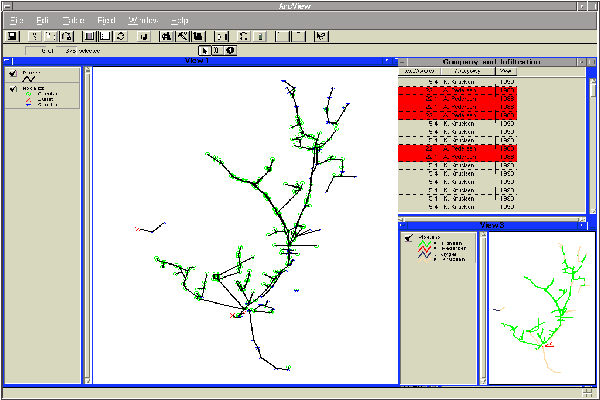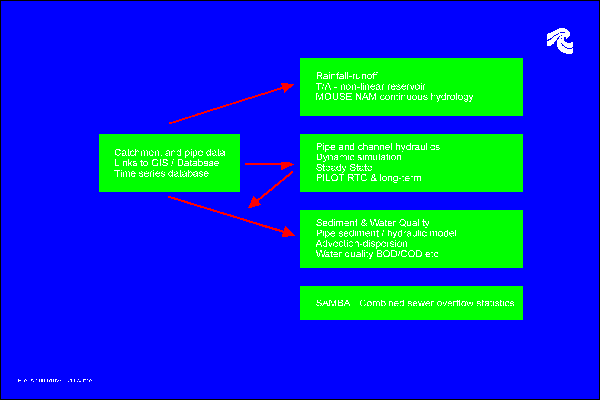Henrik G. Muller, Sten Lindberg, Danish Hydraulic Institute Agern Alle 5, DK-2970 Horsholm, Denmark, Telephone +45 45 76 95 55, Fax +45 45 76 25 67
 Figur 1. The MOUSE Model Editor - Unscaled image
Figur 1. The MOUSE Model Editor - Unscaled image
GIS systems are useful tools for visualising the projected developments in Metropolitan areas, in terms of changes in population, industrial patterns, infrastructural utilities, etc. One very interesting aspect in this context, is the expected future load and behaviour of sewer systems, which convey the foul and industrial waste-water flow to sewage treatment plants.
Large sewer systems are structurlly very complex, often, with overflow chambers and loops. The hydraulic performance and capacity can only be evaluated by use of comprehensive mathematical modelling tools.
This paper describes one of the main problems when setting up large sewer networks models to be used for the urban drainage modelling system MOUSE.
The MOUSE Model Editor is an ArcView application where the user can interactively select the relevant nodes, pumps and weirs to be included in the final model network.
The MOUSE simulation results (overflow volumes, average and extreme filling of pipes etc.) are available to the MOUSE Model Editor application for graphical display and further analyses.
Geographical Information Systems (GIS) are among the relatively young software technologies which are rapidly finding a role in the management of urban drainage systems. GIS provides an excellent platform for facility management and planning.
As one step towards an efficient integration between the MOUSE modelling system and GIS technologies, DHI has developed the MOUSE Model Editor application using the ArcView and Avenue from Environmental System Research Institute (Esri). This application offers the user an interactive tool for the definition of sewer network systems to be used for simulation in the MOUSE package.
MOUSE is a professional engineering software package for the simulation of surface runoff, flows, water quality and sediment transport in urban catchments and sewer systems. The program can be equally successfully applied in any other type of pipe networks with alternating free surface and low pressurised flows.
MOUSE is a dynamic, user-friendly modelling tool for the analysis, design, management and operation of both simple and large pipe networks. It provides a complete and effective working environment for sophisticated urban drainage and sewer engineering.
By applying MOUSE it is possible to obtain answers to questions such as:
Integrated Modular Structure
The Standard MOUSE includes versatile computational models for surface runoff in urban catchments and hydrodynamic analysis of flows in pipe networks.
Add-on modules are available for advanced analyses and design:
The modular structure offers great flexibility:
 Figur 2 Modular Structure of MOUSE - Unscaled image
Figur 2 Modular Structure of MOUSE - Unscaled image
The Pipe Flow Model performs the computations of unsteady flow in pipe networks. The computations are founded on an implicit, finite difference numerical solution of the 1D, free surface flow equations (Saint Venant). The implemented algorithm provides efficient and accurate solutions in multiply connected, branched and looped pipe networks.
The computational scheme is applicable to vertically homogeneous flow conditions which occur in pipes ranging from small- profile collectors for detailed urban drainage, to low-lying, often pressurised sewer mains, affected by a varying outlet water level. Both subcritical and supercritical flows are treated by means of the same numerical scheme which is adaptive according to the local flow conditions. Naturally, flow features like backwater effects and surcharges are simulated. Pressurised flow computations are facilitated through the implementation of a narrow 'slot', as a vertical extension of a closed pipe cross section.
The complete non-linear flow equations can be solved for user-specified or automatically supplied boundary conditions. In addition to the fully dynamic description, simplified flow descriptions are also available.
Within the Pipe Flow Model, advanced computational formulations enable the description of a variety of pipe network elements and flow phenomena including:
With such a description, the Pipe Flow Model can predict the detailed hydraulic conditions throughout the pipe network. Depending on the purpose of the study, the user may specially concentrate on the following aspects:
As opposed to the high level of detail necessary when storing sewer asset and management data in dedicated database systems, the level of detail required for hydraulic modelling is much simpler.
Even with the highly sophisticated hydrodynamic tools as MOUSE, including every single minor component will not improve the accuracy of the model due primarily to the uncertainty in the hydraulic input data ( rainfall, foul flow, etc.). Hence there is a need to simplify the network from the database level to the model network.
The developed ArcView application allows the user the possibility to extract data from the asset management system, condense it semi-automatically - while monitoring consistency in the description of the physical system - and then store the data as a model description for use in MOUSE.
The MOUSE Model Editor includes a wide range of facilities:
Abbott, M. B., Lindberg, S., Havn›, K., The fourth generation of numerical modelling in hydraulics. In: Journal of Hydraulic Research, 1991, vol. 29, no 5, pp. 581-600
Lindberg, S., Willemoes Jorgensen, T., Modelling of urban storm sewer systems. Urban Drainage Modelling, UDM '86, Dubrovnik, Yugoslavia, 1986
Lindberg, S., Nielsen, J. B., Carr, R., An integrated PC-modelling system for hydraulic analysis of drainage systems. Watercomp '89, Melbourne, Australia, 1989